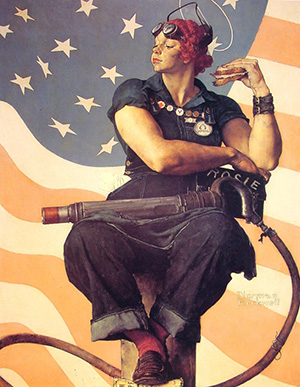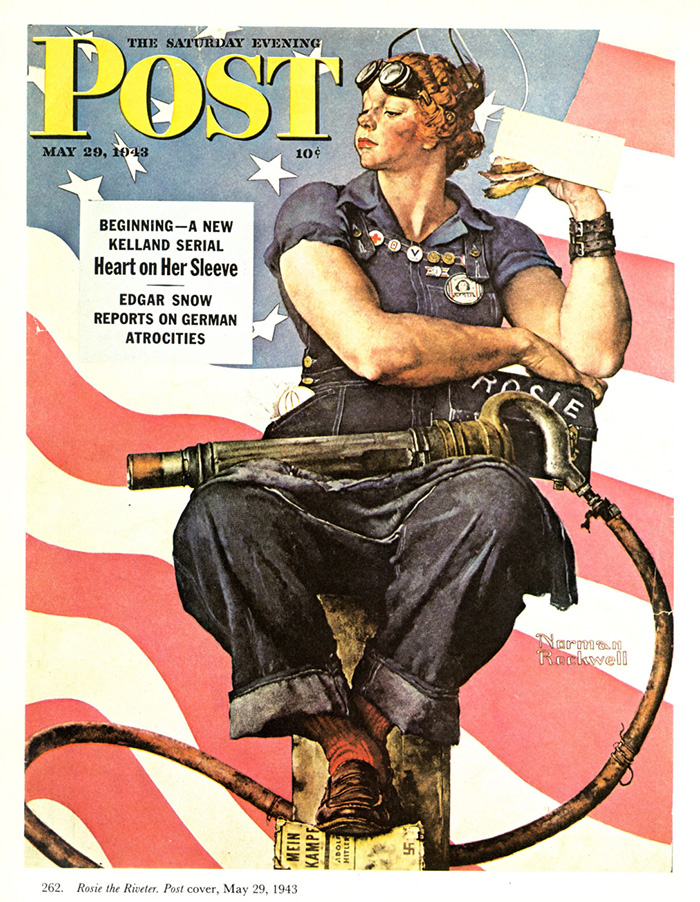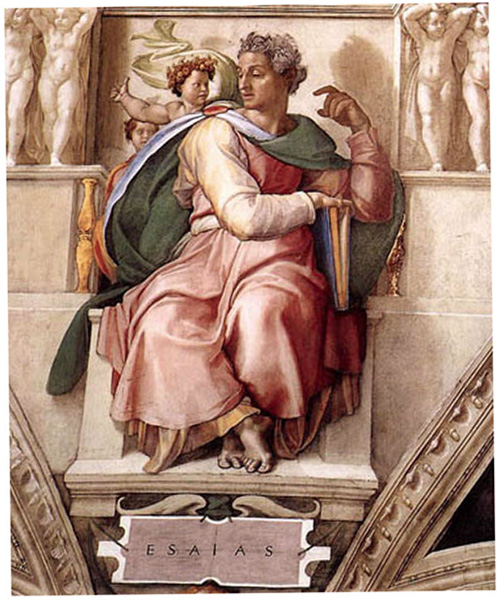Rosie The Riveter – 1943
Saturday Evening Post cover May 29, 1943.
Norman Rockwell’s Rosie the Riveter received mass distribution on the cover of the Saturday Evening Post on Memorial Day, May 29, 1943. Rockwell’s illustration features a brawny woman taking her lunch break with a rivet gun on her lap, beneath her a copy of Hitler’s manifesto, Mein Kampf and a lunch pail labled “Rosie”. Rockwell based the pose to match Michelangelo’s Sistine Chapel ceiling painting of the prophet Isaiah.
Rockwell’s model was a Vermont resident, then 19-year-old Mary Doyle Keefe who was a telephone operator near where Rockwell lived, not a riveter. Rockwell painted his “Rosie” as a larger woman than his model, and he later phoned to apologize. The Post’s cover image proved hugely popular, and the magazine loaned it to the U.S. Treasury Department for the duration of the war, for use in war bond drives.

Norman Rockwell (1894-1978)
Rosie the Riveter, 1943.
Cover illustration for The Saturday Evening Post, published on May 29, 1943.
©1943 SEPS: Licensed by Curtis Licensing, Indianapolis, IN
VIDEO
Below is a video interview with the model for “Rosie the Riveter” Mary Doyle Keefe.
REFERENCE PHOTOS
AUDIO
Listen to the adult and family audio segments from the Museum’s digital gallery tour for Home for Christmas.
Learn more about the Museum’s Digital Gallery Tour.
Adult Audio (coming soon) In the mean time, please refer to the transcript below…
Family Audio (coming soon) In the mean time, please refer to the transcript below…
ABOUT – Rosie the Riveter
After the war, the Rockwell “Rosie” was seen less and less because of a general policy of vigorous copyright protection by the Rockwell estate. In 2002, the original painting sold at Sotheby’s for nearly $5 million. In June 2009 the Crystal Bridges Museum of American Art in Bentonville, Arkansas acquired Norman Rockwell’s iconic Rosie the Riveter painting for its permanent collection from a private collector.
In late 1942, Doyle posed twice for Rockwell’s photographer, Gene Pelham, as Rockwell preferred to work from still images rather than live models. The first photo was not suitable because she wore a blouse rather than a blue work shirt. In total, she was paid $10 for her modeling work (equivalent to $138 in 2016). In 1949 she married Robert J. Keefe to become Mary Doyle Keefe. The Keefes were invited and present in 2002 when the Rockwell painting was sold at Sotheby’s.
In an interview in 2014, Keefe said that she had no idea what impact the painting would have. “I didn’t expect anything like this, but as the years went on, I realized that the painting was famous,” she said. Keefe died on April 21, 2015, in Connecticut at the age of 92.




